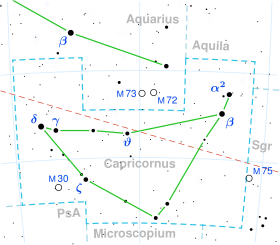| Observation data Epoch J2000 Equinox J2000 | |
|---|---|
| Constellation | Capricornus |
| Right ascension | 20h 46m 05.73263s[1] |
| Declination | −25° 16′ 15.2312″[1] |
| Apparent magnitude (V) | 4.13[2] |
| Characteristics | |
| Spectral type | F5 V[3] |
| U−B color index | −0.03[2] |
| B−V color index | +0.42[2] |
| Astrometry | |
| Radial velocity (Rv) | +20.3[4] km/s |
| Proper motion (μ) | RA: −51.96[1] mas/yr Dec.: −156.56[1] mas/yr |
| Parallax (π) | 68.13 ± 0.27 mas[1] |
| Distance | 47.9 ± 0.2 ly (14.68 ± 0.06 pc) |
| Absolute magnitude (MV) | 3.33[5] |
| Details | |
| Mass | 1.37[6] M☉ |
| Radius | 1.51+0.08 −0.04[7] R☉ |
| Luminosity | 3.82±0.03[7] L☉ |
| Surface gravity (log g) | 4.25[6] cgs |
| Temperature | 6,572+89 −173[7] K |
| Metallicity [Fe/H] | 0.15[6] dex |
| Rotational velocity (v sin i) | 40.9±2.0[8] km/s |
| Age | 1.4[3] Gyr |
| Other designations | |
| Database references | |
| SIMBAD | data |
Psi Capricorni, Latinized from ψ Capricorni, is a single[10] star in the southern zodiac constellation of Capricornus. It is a yellow-white hued star that is faintly visible to the naked eye with an apparent visual magnitude of +4.13.[2] The distance to this star is approximately 47.9 light years based on parallax measurements,[1] and it is drifting further away with a radial velocity of +20 km/s.[4] The closest approach to the Sun occurred some 467,000 years ago at a separation of 20 light-years.[11]
This object is an F-type main-sequence star with a stellar classification of F5 V.[3] It is 1.4[3] billion years old with 1.4[6] times the mass of the Sun. The measured rotational velocity of this star is approximately 41 km/s[8] (the Sun has an equatorial rotation velocity of 2 km/s). Analysis of the line profile of the star's spectrum indicates that it is undergoing differential rotation, with the variation by latitude being similar to the Sun.[12] The star has 1.5[7] times the Sun's radius and is radiating 3.8[7] times the luminosity of the Sun from its photosphere at an effective temperature of 6,572 K.[7] It displays an infrared excess, suggesting the presence of an orbiting debris disk at a separation of 38.75 AU and a temperature of 60 K.[13]
- ^ a b c d e f Cite error: The named reference
aa474_2_653was invoked but never defined (see the help page). - ^ a b c d Cite error: The named reference
MERMILLIODwas invoked but never defined (see the help page). - ^ a b c d Cite error: The named reference
aaa523_A73was invoked but never defined (see the help page). - ^ a b Cite error: The named reference
paas21_2_129was invoked but never defined (see the help page). - ^ Cite error: The named reference
Reiners2006was invoked but never defined (see the help page). - ^ a b c d Cite error: The named reference
Luck2018was invoked but never defined (see the help page). - ^ a b c d e f Cite error: The named reference
GaiaDR2was invoked but never defined (see the help page). - ^ a b Cite error: The named reference
AmmlerVonEiff2012was invoked but never defined (see the help page). - ^ Cite error: The named reference
SIMBADwas invoked but never defined (see the help page). - ^ Cite error: The named reference
Eggleton2008was invoked but never defined (see the help page). - ^ Cite error: The named reference
BailerJones2015was invoked but never defined (see the help page). - ^ Cite error: The named reference
aa376_L13was invoked but never defined (see the help page). - ^ Cite error: The named reference
Gáspár2016was invoked but never defined (see the help page).
